Module 4 - Biodiversity, evolution, disease
0.0(0)
0.0(0)
Card Sorting
1/162
There's no tags or description
Looks like no tags are added yet.
Study Analytics
Name | Mastery | Learn | Test | Matching | Spaced |
|---|
No study sessions yet.
163 Terms
1
New cards
2
New cards
3
New cards
4
New cards
5
New cards
__**Disease:**__
\
Name 2 common vectors
\
Name 2 common vectors
Water, insects
6
New cards
__**Disease:**__
Identify two ways Bacteria can be classified by:
Identify two ways Bacteria can be classified by:
* their basic shapes
* Their cell walls
* Their cell walls
7
New cards
__**Disease:**__
What colour does the cell wall of Gram negative bacteria show up as on a microscope when stained?
What colour does the cell wall of Gram negative bacteria show up as on a microscope when stained?
Red
8
New cards
__**Disease:**__
Why is it useful that we can identify the type of cell walls in bacteria?
Why is it useful that we can identify the type of cell walls in bacteria?
Because the type of cell wall of bacteria affects how it will react to antibiotics
9
New cards
__**Disease:**__
What colour does the cell wall of Gram positive show up as on a microscope when stained?
What colour does the cell wall of Gram positive show up as on a microscope when stained?
Purple
10
New cards
__**Disease:**__
\
List 3 bacterial pathogens that can cause communicable diseases in plants and animals
\
List 3 bacterial pathogens that can cause communicable diseases in plants and animals
* Tuberculosis
* Bacterial meningitis
* Ring rot
\
* Bacterial meningitis
* Ring rot
\
11
New cards
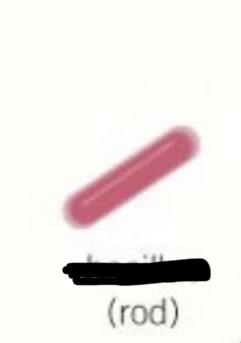
__**Disease:**__
What is the name of the bacteria shown here?
What is the name of the bacteria shown here?
Bacillus
12
New cards

__**Disease:**__
What is the name of the bacteria shown here?
What is the name of the bacteria shown here?
Chain of bacilli
13
New cards
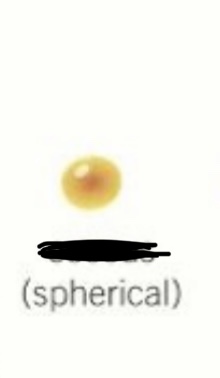
__**Disease:**__
What is the name of the bacteria shown here?
What is the name of the bacteria shown here?
Coccus
14
New cards

__**Disease:**__
What is the name of the bacteria shown here?
What is the name of the bacteria shown here?
Pair of cocci
15
New cards

__**Disease:**__
What is the name of the bacteria shown here?
What is the name of the bacteria shown here?
Chain of cocci
16
New cards
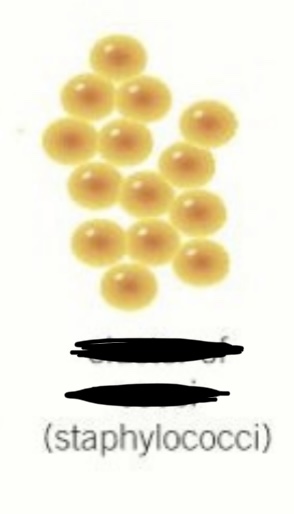
__**Disease:**__
What is the name of the bacteria shown here?
What is the name of the bacteria shown here?
Cluster of cocci
17
New cards
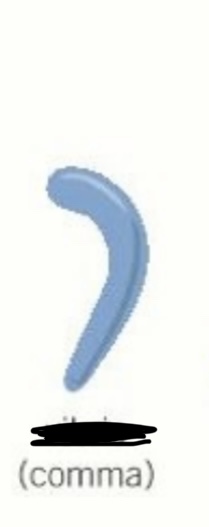
__**Disease:**__
What is the name of the bacteria shown here?
What is the name of the bacteria shown here?
Vibrio
18
New cards

__**Disease:**__
What is the name of the bacteria shown here?
What is the name of the bacteria shown here?
Spirillum
19
New cards
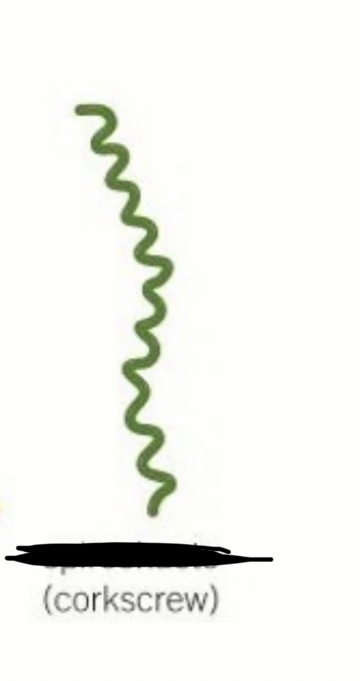
__**Disease:**__
What is the name of the bacteria shown here?
What is the name of the bacteria shown here?
Spirochaete
20
New cards
__**Disease:**__
How can bacterial infections in animals be treated?
How can bacterial infections in animals be treated?
Antibiotics
21
New cards
__**Disease:**__
\
What is a vector? \*
\
What is a vector? \*
Something that can carry and transmit a pathogen from one organism to another
22
New cards
__**Disease:**__
\
List 3 viral pathogens that can cause communicable diseases in plants and animals
\
List 3 viral pathogens that can cause communicable diseases in plants and animals
* HIV/AIDS
* Influenza
* Tobacco mosaic virus
* Influenza
* Tobacco mosaic virus
23
New cards
__**Disease:**__
\
Name 2 Protoctist pathogens that can cause communicable diseases in plants and animals
\
Name 2 Protoctist pathogens that can cause communicable diseases in plants and animals
* Malaria
* Potato blight
* Potato blight
24
New cards
__**Disease:**__
\
List 3 Fungal pathogens that can cause communicable diseases in plants and animals
\
List 3 Fungal pathogens that can cause communicable diseases in plants and animals
* Black sigatoka
* Ringworm
* Athletes foot
* Ringworm
* Athletes foot
25
New cards
__**Disease:**__
\
Is Tuberculosis bacterial, fungal, viral or protoctista
\
Is Tuberculosis bacterial, fungal, viral or protoctista
Bacterial
26
New cards
__**Disease:**__
\
Is Bacterial meningitis bacterial, fungal, viral or protoctista
\
Is Bacterial meningitis bacterial, fungal, viral or protoctista
Bacterial
27
New cards
__**Disease:**__
\
Is ring rot bacterial, fungal, viral or protoctista
\
Is ring rot bacterial, fungal, viral or protoctista
Bacterial
28
New cards
__**Disease:**__
\
Is HIV/AIDS bacterial, fungal, viral or protoctista
\
Is HIV/AIDS bacterial, fungal, viral or protoctista
Viral
29
New cards
__**Disease:**__
\
Is influenza bacterial, fungal, viral or protoctista
\
Is influenza bacterial, fungal, viral or protoctista
Viral
30
New cards
__**Disease:**__
\
Is TMV bacterial, fungal, viral or protoctista
\
Is TMV bacterial, fungal, viral or protoctista
viral
31
New cards
__**Disease:**__
\
Is malaria bacterial, fungal, viral or protoctista
\
Is malaria bacterial, fungal, viral or protoctista
Protoctista
32
New cards
__**Disease:**__
\
Is potato/tomato late blight bacterial, fungal, viral or protoctista
\
Is potato/tomato late blight bacterial, fungal, viral or protoctista
Protoctista
33
New cards
__**Disease:**__
\
Is black sigatoka bacterial, fungal, viral or protoctista
\
Is black sigatoka bacterial, fungal, viral or protoctista
fungal
34
New cards
__**Disease:**__
\
Is ringworm bacterial, fungal, viral or protoctista
\
Is ringworm bacterial, fungal, viral or protoctista
fungal
35
New cards
__**Disease:**__
\
Is Athlete’s foot bacterial, fungal, viral or protoctista
\
Is Athlete’s foot bacterial, fungal, viral or protoctista
fungal
36
New cards
__**Disease:**__
\
List 3 direct transmission methods of spreading disease in animals
\
List 3 direct transmission methods of spreading disease in animals
* Direct contact
* Inoculation
* Ingestion
* Inoculation
* Ingestion
37
New cards
__**Disease:**__
\
List 3 indirect transmission methods of spreading disease in animals
\
List 3 indirect transmission methods of spreading disease in animals
* Fomites
* Droplets of infection
* Vectors
* Droplets of infection
* Vectors
38
New cards
__**Disease:**__
\
Factors 5 affecting Transmission of Disease in Animals
\
Factors 5 affecting Transmission of Disease in Animals
* Overcrowding
* Poor nutrition
* Vulnerable immune system
* Disposal of waste
* Climate change
* Poor nutrition
* Vulnerable immune system
* Disposal of waste
* Climate change
39
New cards
__**Disease:**__
\
List a direct transmission method of spreading disease in plants
\
List a direct transmission method of spreading disease in plants
* Contact with leaves
40
New cards
__**Disease:**__
\
List 5 direct transmission methods of spreading disease in animals
\
List 5 direct transmission methods of spreading disease in animals
* Soil contamination
* Wind
* Water
* Animals
* Humans
* Wind
* Water
* Animals
* Humans
41
New cards
__**Disease:**__
\
List 5 Factors affecting transmission of disease in plants
\
List 5 Factors affecting transmission of disease in plants
* susceptibility of disease
* Overcrowding
* Resistance
* Climate conditions
* Overcrowding
* Resistance
* Climate conditions
42
New cards
__**Disease :**__
\
name 3 primary physical defence barriers to prevent the entry of disease in plants
\
name 3 primary physical defence barriers to prevent the entry of disease in plants
* waxy cuticle
* Bark (trees)
* Cellulose cell walls
* Bark (trees)
* Cellulose cell walls
43
New cards
__**Disease:**__
\
Do plants attempt to heal disease in damaged tissue if no, what do they do instead?
\
Do plants attempt to heal disease in damaged tissue if no, what do they do instead?
No, they section it off
44
New cards
__**Disease:**__
What type of defence is callose deposition an example of in plans ?
What type of defence is callose deposition an example of in plans ?
Mechanical /physical
45
New cards
__**Disease:**__
Do plants heal damaged tissue?
Do plants heal damaged tissue?
No
46
New cards
__**Disease:**__
\
What do plants do to damaged tissue?
\
What do plants do to damaged tissue?
They section it off
47
New cards
__**Disease:**__
Gap fill…
(Number of dots doesn’t represent number of letters in missing word)
\
Callose papillae act as ………, ………… the pathogen entering the plant ……… around the site of ………..
Gap fill…
(Number of dots doesn’t represent number of letters in missing word)
\
Callose papillae act as ………, ………… the pathogen entering the plant ……… around the site of ………..
barriers, preventing, cells, infection
48
New cards
__**Disease:**__
\
What may be added to the plants mechanical barrier to make t thicker/ stronger?
\
\
What may be added to the plants mechanical barrier to make t thicker/ stronger?
\
lignin
49
New cards
Disease:
\
Why may lignin be added to plant tissue during infection?
\
Why may lignin be added to plant tissue during infection?
to make it stronger and thicker
50
New cards
Disease:
\
What does callose do?
\
What does callose do?
prevents the spread of pathogens, blocks sieve plates in the phloem
51
New cards
Disease:
\
Why may callose deposited?
\
Why may callose deposited?
to seal off infected parts of the plant and prevent the spread of pathogens
52
New cards
Disease:
\
Where is callose deposited? \*\*\*
\
Where is callose deposited? \*\*\*
in plasmodesmata, between infected cells
53
New cards
Disease:
\
Why do plants produce powerful chemicals?
\
Why do plants produce powerful chemicals?
to repel insect vectors/ kill invading pathogens
54
New cards
Disease:
\
Give an example of insect repellents
\
Give an example of insect repellents
pine resin
55
New cards
Disease:
\
Name 6 chemical defences in plants…
\
Name 6 chemical defences in plants…
insect repellents, insecticides, antibacterial compounds, antifungal compounds, anti-oomycetes
56
New cards
Disease:
\
Give an example of an insecticide…
\
Give an example of an insecticide…
Caffeine
57
New cards
Disease:
\
Give a named antibacterial compound in plants…
\
Give a named antibacterial compound in plants…
Phenols
58
New cards
Disease:
\
Give 2 named examples of antibacterial compounds in plants …
\
Give 2 named examples of antibacterial compounds in plants …
Phenols, chitinases
59
New cards
Disease:
\
What are chitinases and what do they do?
\
What are chitinases and what do they do?
enzymes, break down chitin in fungal cells
60
New cards
Disease:
\
Give an example of an anti-oomycetes…
\
Give an example of an anti-oomycetes…
\
Glucanases
Glucanases
61
New cards
Disease:
\
Give a named example of a general toxin…
\
Give a named example of a general toxin…
Cyanide
62
New cards
Disease:
Gap fill…
(Number of dots doesn’t represent number of letters in missing word)
\
………. is toxic to most …….. ……..
\
Gap fill…
(Number of dots doesn’t represent number of letters in missing word)
\
………. is toxic to most …….. ……..
\
Cyanide, living things
63
New cards
Disease:
\
What triggers callose deposition?
\
\
What triggers callose deposition?
\
Plant cells recognises pathogenic molecules / breakdown products of cell wall are recognised, signalling molecules alert nucleus to attack
64
New cards
Disease:
\
Which is faster, the non-specific immune system or the specific immune system?
\
Which is faster, the non-specific immune system or the specific immune system?
Non-specific immune system
65
New cards
Disease:
\
What are 4 ways our bodies prevent the entry of pathogens?
\
What are 4 ways our bodies prevent the entry of pathogens?
Skin, mucous membranes, lysozymes in tears and stomach acid, blood clotting
66
New cards
Disease:
\
How is skin adapted to prevent entry of pathogens?
\
How is skin adapted to prevent entry of pathogens?
Produces sebum, which inhibits growth of pathogens
67
New cards
Disease:
\
Where can mucous membranes be found?
\
Where can mucous membranes be found?
gas exchange system, airways
68
New cards
Disease:
\
Why are mucous membranes effective at keeping pathogens out?
\
Why are mucous membranes effective at keeping pathogens out?
They secrete sticky mucous which trap micro-organisms , the lysozymes destroy the fungal and bacterial cell walls. mucous also contains phagocytes to remove the remaining pathogens
69
New cards
Disease:
\
State 4 expulsive reflexes the body has…
\
State 4 expulsive reflexes the body has…
Coughing, sneezing, vomitting and diarrhoea
70
New cards
Disease:
\
What do expulsive reflexes such as coughing and sneezing do?
\
What do expulsive reflexes such as coughing and sneezing do?
They eject mucous full of pathogens out of the gas exchange system
71
New cards
Disease:
\
What do expulsive reflexes such as vomiting and diarrohea do?
\
What do expulsive reflexes such as vomiting and diarrohea do?
expel the contents of the gut and pathogens
72
New cards
**Disease:**
\
What is the name of the enzyme that triggers the formation of a blood clot?
\
What is the name of the enzyme that triggers the formation of a blood clot?
Thromboplastin
73
New cards
Disease:
\
What does thromboplastin do?
\
What does thromboplastin do?
The enzyme that triggers the formation of a blood clot
74
New cards
Disease:
\
Why is it important that blood clots rapidly form when the skin is breached?
\
Why is it important that blood clots rapidly form when the skin is breached?
To prevent the entry of pathogens
75
New cards
Disease:
\
What is the role of the serotonin in blood clotting and wound repair?
\
What is the role of the serotonin in blood clotting and wound repair?
Causes smooth muscles in blood vessels to contract, making the blood vessels narrow) to reduce bleeding and blood supply to the area.
76
New cards
Disease:
\
What happens when the blood clot has formed?
\
What happens when the blood clot has formed?
blood clot dries out and scab is formed
77
New cards
Disease:
\
Why are scabs important?
\
Why are scabs important?
to prevent the entry of pathogens
78
New cards
Disease:
\
What happens when the skin under the blood clot has returned to its original thickness?
\
What happens when the skin under the blood clot has returned to its original thickness?
Scab falls off
79
New cards
Disease:
\
After injury when does a scab fall off?
\
After injury when does a scab fall off?
When the new epidermis reaches normal thickness
80
New cards
Disease:
\
What type of response is the inflammatory response?
\
What type of response is the inflammatory response?
Localised response, primary response
81
New cards
Disease:
\
What can inflammation be characterised by?
\
What can inflammation be characterised by?
pain, heat, redness, swelling
82
New cards
Disease:
\
What is the name of the cells that are activated when tissue is damaged?
\
What is the name of the cells that are activated when tissue is damaged?
Mast cells
83
New cards
Disease:
\
What are the names of the chemicals secreted by the mast cells?
\
What are the names of the chemicals secreted by the mast cells?
Histamines and cytokines
84
New cards
Disease:
\
Why is localised heat/ raised body temperature good?
\
Why is localised heat/ raised body temperature good?
prevents pathogens from reproducing
85
New cards
Disease:
\
How does swelling occur?
\
How does swelling occur?
Histamines cause blood vessels to dilate, they become more leaky forcing blood plasma out of the blood, this is called tissue fluid
86
New cards
Disease:
\
What is the name of blood plasma once forced out of the blood?
\
What is the name of blood plasma once forced out of the blood?
tissue fluid
87
New cards
Disease:
\
What is the role of cytokines?\*\*\*
\
What is the role of cytokines?\*\*\*
88
New cards
Disease:
\
What can the inflammatory response cause if an infection is wide spread?
\
What can the inflammatory response cause if an infection is wide spread?
Whole body rash
89
New cards
Disease:
\
What happens if pathogens get into the body?
\
What happens if pathogens get into the body?
The body tries to prevent them from reproducing and tries to kill them
90
New cards
Disease:
\
Which part of the brain controls and regulates body temperature?
\
Which part of the brain controls and regulates body temperature?
hypothalamus
91
New cards
Disease:
\
What is the normal body temperature? (°C)
(Roughly)
\
What is the normal body temperature? (°C)
(Roughly)
37
92
New cards
Disease:
\
Why are fevers important?
\
Why are fevers important?
Prevents pathogens from reproducing, specific immune system works better at higher temperatures.
93
New cards
Disease:
\
What are specialised white blood cells called?
\
What are specialised white blood cells called?
Phagocytes
94
New cards
Disease:
True/False
\
Macrophages have a lobed nucleus.
True/False
\
Macrophages have a lobed nucleus.
False
95
New cards
Disease:
\
What does pus consist of?
\
What does pus consist of?
Dead neutrophils and pathogens
96
New cards
Disease:
\
What are the 2 main phagocytes called?
\
What are the 2 main phagocytes called?
Neutrophils, macrophages
97
New cards
Disease:
\
What is the name of the vacuole in which the phagocyte engulfs the pathogen?
\
What is the name of the vacuole in which the phagocyte engulfs the pathogen?
Phagosome
98
New cards
Disease:
\
What is it called when the phagosome with the pathogen inside combines with a lysosome?
\
What is it called when the phagosome with the pathogen inside combines with a lysosome?
Phagolysosome
99
New cards
Disease:
\
Is phagocytosis a specific response?
\
Is phagocytosis a specific response?
no
100
New cards
Disease:
\
What is a phagolysosome?
\
What is a phagolysosome?
Phagosome combined with lysosome